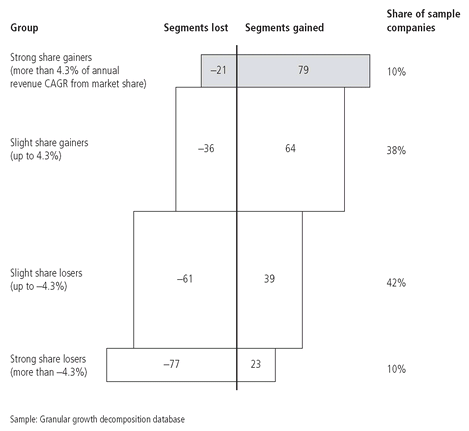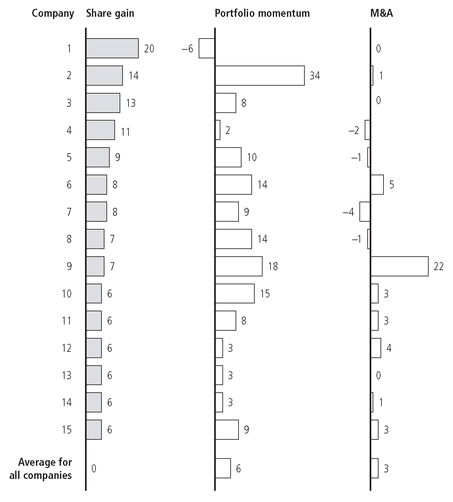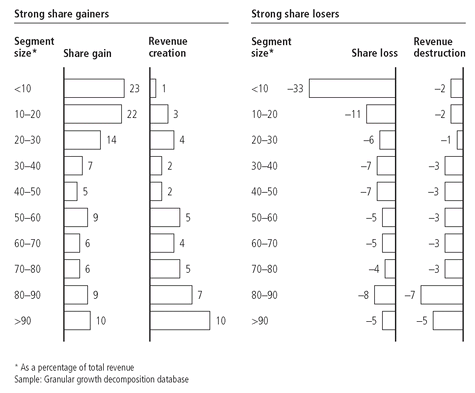7
Firing on Firing on share gain
“The strongest principle of growth lies in human choice.”
George Eliot, Daniel Deronda
• Market-share gain is not the main driver of growth and differential growth performance, but it is still important
• In the short term, gaining market share can boost revenue growth
• Gaining substantial share is difficult to achieve and even harder to sustain
• To do it, you need either an advantage that stands out a mile or the ability to change the rules of the game
AS WE’VE SEEN, market-share gain is not the main driver of either growth or differences in growth performance. Our analysis shows that over a five-year period, it explains only about 21 percent of the difference in growth performance within our sample of large companies.
But that’s not to say that share gain is unimportant. In the short term, actions that boost market share can also boost revenue growth. Indeed, if we shrink the timeframe we considered in chapter 2 to a single year, share gain becomes much more important. Similarly, across one-year periods, share gains and losses account for 26 percent of differences in growth performance in aggregate, spiking to as high as 33 percent in a single year.
In addition, market-share performance is always important from a company’s point of view because loss of share tends to be judged harshly. Your share loss is your competitor’s share gain. In a world that often judges a company’s performance against that of its peers, CEOs are seldom forgiven for a deteriorating share trajectory.
Finally, a loss of market share may lead to a reduction in margin. As we describe in Appendix 2, the “grow” path requires margins to be maintained or increased. In this sense, losing market share could mean that growth doesn’t create shareholder value.
A tough task
So gaining market share is important. It’s also extremely challenging. Among the companies in our granular growth decomposition sample, only about one in ten achieved substantial share gain. By this, we mean that they derived more than 4 percentage points of their overall annual revenue growth from share gain (note that this doesn’t mean they gained 4 points of market share a year!).
That so few companies attained this level of performance shows how difficult it is to obtain strong growth by firing on this one cylinder alone. The task becomes even more of a challenge if you are in a sector that isn’t benefiting from a tailwind because all the players are likely to be focused on share battles.
When we look at the market-share performance of the companies in our growth decomposition database, we find that the share gainers and losers tend to fire or misfire on share across the board. In other words, winners do well in most (79 percent) of their segments, while losers perform poorly in most (77 percent) of theirs (
Figure 7.1).
It’s important to note, though, that 80 percent of companies gain or lose only a small amount of market share in aggregate. To get a real sense of what’s happening, you have to look deeper to find the segments that are firing and the ones that aren’t. In this sense, share firing is very granular for most companies: if your market-share performance varies from one segment to another, you’re unlikely to be firing on the share cylinder at the company level.
Since achieving growth through share gain is so difficult, a company that has chosen this route must have a clear understanding of how to succeed at it.
Fig 7.1 Market-share performance by segments
Percent of segments gained or lost by group
Learning from the winners
The top fifteen share gainers in our sample from 1999 to 2005 did succeed in gaining substantial share. The contribution to annual revenue growth made by share gain ranged from 6 to 20 percentage points (
Figure 7.2). Given such substantial shifts, it’s fair to say that these companies transformed the markets they were competing in. But how did they do it?
Contribution to annual revenue growth rate, 1999-2005, percentage points
Source: SDC; Hoovers; company reports; analyst reports; McKinsey analysis
Before a company can gain share, it obviously needs some kind of edge over those companies from which it takes share. When we analyzed the top fifteen share gainers, one thing stood out: they’ve all made big choices—strong commitments to create distinctive (and possibly disruptive) business models—on the basis of insights or distinctive advantages. Not all big choices are rewarded by share gain, of course. However, it does seem that fortune favors the brave, or at least those with expansive mindsets.
To illustrate this, let’s take a quick glance at five of the fifteen star performers.
Dell: Fresh thinking about the supply chain
Dell’s share gain is the result of its distinctive insight into the evolution of the computer hardware industry, coupled with its advantage in supply-chain management, which has been well documented.
1 By selling direct to customers, it was able to grow organically at 13 percent in a market that was itself contracting (by 6 percent between 1999 and 2005).
Dell used its insight to make a big choice about the nature of its business model and its approach to the supply chain before putting in the operational work needed to make it happen. If all that hard work had been directed toward a “me too” approach, Dell’s growth history would have looked very different.
Valero: High-complexity refining
As we saw in chapter 3, Valero is one of the rare companies that fires on all growth cylinders. In the period between 1981 and 2005, Valero made a huge bet by investing in heavy-crude refining. The capabilities and insight it built over two decades paid off when commodity prices skyrocketed.
The company bought its first refinery in Corpus Christi, Texas, in 1981. The refinery was designed to process heavy, sour grades of crude, which are much more complex to refine than the more popular lighter, sweeter grades. Valero committed $1 billion to upgrading the refinery and began to build capabilities for producing clean fuel (reformulated gasoline) using sour crude and heavily discounted residual fuel.
Its decision to acquire refineries that others found unattractive stemmed from top management’s insight that environmental regulations would increase the demand for clean fuel. This commitment paid off in revenue terms: from 1999 to 2005, Valero’s markets grew by 18 percent CAGR and organic share gain by 7 percent CAGR.
Valero’s capability is not confined to capturing market share and tapping into a booming market. It also uses M&A extensively and has developed skills at turning around acquisitions—even troubled ones such as Orion Refining, which it acquired at a bargain price. By making the right granular choices and building the right capabilities, it has been able to create a clear advantage over competitors in the industry and gain significant market share.
Toyota: Quality at affordable prices
Toyota’s performance is exceptional: it has gained share in all of the 19 markets in which it operates, apart from two small segments in Asia (outside Japan). When it comes to share gain, North America is by far its most important market, and represents almost half the total increase.
The company claims its advantage lies in its ability to offer high quality and reliability at affordable prices. It achieves this through its commitment to the Toyota Production System, which pioneered lean manufacturing methods that have since been adopted in many other industries around the world. This radically different approach to operations is undoubtedly a key factor in explaining Toyota’s share gain.
Centrica: Changing the retail energy game
Not every company that achieves substantial share gain is as well known or possesses such global reach as Toyota. Consider Centrica, which has achieved a remarkable turnaround largely through its advantage in its UK operations.
In the 1990s, Centrica (then the retail arm of British Gas) suffered heavy market-share losses following the deregulation of its industrial and residential gas businesses in the UK. But the tide turned in 1998. Although its share of the residential gas market was still dwindling, the company took advantage of the opening up of the residential electricity market to attack regional incumbents. Its expansion was successful: five years later, Centrica had become the market leader, with a share that had soared from zero in 1998 to 24 percent in 2003.
Centrica’s advantage was twofold. First, it had privileged assets: its customer base in the gas business and its brand recognition. Even though it had lost substantial market share, Centrica was still serving about 80 percent of UK households at the time it launched its electricity offering. This put it in a privileged position to offer its customers both gas and electricity.
Which brings us to the second source of advantage: Centrica’s insight that a dual-fuel offer would be a key success factor and that it was well placed to provide such an offer. History proved it right: market research published in 2001 revealed that consumers choosing a utility provider rated a dual-fuel offer as the second most important factor after price.
Samsung: Betting on new technology
In recent years, Samsung Electronics has had a stupendous track record in share gain, especially in the telecommunications and semiconductor segments. Our granular growth decomposition analysis reveals that these two segments account for an overwhelming part of its share gain between 1999 and 2005. Although we agree with commentators that great branding is one source of Samsung’s stellar performance, especially in consumer electronics, we don’t think it is the only one. We would also point to the big choices made by Samsung’s chairman Kun-Hee Lee—choices based on his insight into the market on the one hand and a set of truly exceptional growth capabilities on the other.
Let’s hone in on telecommunications, which contributed more than half of Samsung’s total share gain. In this segment, the two major choices it made were to commit to CDMA
2 technology and to adopt a “fast-integrator model”
3 that allowed it to test and develop new products quickly, so helping it to gain share through rapid innovations in a high-momentum competitive arena. It’s hard to beat the combination of a powerful business model and a favorable tailwind.
Samsung’s ability to exploit the fast-integrator model stems not from a one-off effort to improve manufacturing efficiency, but from a distinctive operational competency. So ingrained is its execution focus, that if you were to remove it, you would no longer recognize the company.
Shaping your own destiny
All these examples illustrate that if a company is to achieve substantial share gain, it must make big choices that create advantage. This calls for an expansive mindset. Dell took its direct model into new markets and new products. Valero capitalized on its carefully constructed advantage in complex refineries. Toyota pushed its lean manufacturing system into new segments and countries. Centrica used its knowledge as a gas supplier to expand into electricity. Samsung exploited its ability to take new products to market at unprecedented speed.
If we look at the top fifteen share losers, we naturally see a very different picture. All suffered losses in annual revenue growth: between 5 and 15 percentage points a year. Some of these companies were deliberately exiting certain sub-segments because of poor performance, as Corning did in telecommunications and Fujitsu in components. But most had failed to respond to attacks from others. For instance, First Pacific Company Ltd, a diversified Hong Kong-based company with businesses including consumer food products and telecommunications, didn’t respond to new entrants selling below cost and was overtaken by new business models.
Rather than shaping their destiny through big choices, the share losers were driven by the market. Here lies an important difference between winners and losers. While big gains require big choices (nearly 80 percent of share-gain winners had a distinctive business-model advantage), you don’t have to make a big choice to qualify as a loser, nor do you need a historically distinctive disadvantage. Adopting a passive posture may well be enough. In our sample, half of the share-gain losers had a distinctive disadvantage, while the other half stumbled on execution.
Segment size matters (but not just in the way you think)
As we’ve explained, our granular growth decomposition is derived at a segment level. This means that a company’s share gain or loss is calculated as a weighted average of the difference between its own organic growth rates and the growth rates of the underlying segments. When we look at the leading winners and losers, we find that more often than not, as we saw in
Figure 7.1, they tend to exhibit strong or weak market-share performance across most of their segments.
In this case, segment size matters as well: we find that the larger segments dominate the aggregate revenue impact. Needless to say, strong or weak share-gain performance in a large business has a big impact on revenue; it’s a numbers game. But the upshot is important as well as obvious: small market-share shifts in large segments have a disproportionate effect on the total picture for your company.
When we cut market-share performance by segment size, we see the greatest share extremes in smaller segments, with contributions to annual revenue growth as high as 23 percent and revenue loss as high as 33 percent. However, the biggest impact on revenue growth rates comes from segments representing more than 30 percent of a company’s total revenues (
Figure 7.3).
Short-term wins
We mentioned that market share matters more over shorter time frames. In the space of a single year, market-share performance can be responsible for as much as 33 percent of differences in company growth. What does this mean?
Fig 7.3 How changes in segment share hit revenue
Percent
Many companies pull performance levers that boost revenues quickly: think of transaction pricing, sales stimulation, and even the launch of a new product range. When successful, such actions drive revenue growth and show up in our growth decomp as share gain. The problem is that these short-term revenue-boosting measures rarely make much difference to a company’s fundamental growth trajectory; instead, they eventually get competed away. That’s why market share is less important in our five-year analysis than in our one-year analysis where most companies are concerned.
The message is clear: use tactical actions to boost revenues whenever you can, but don’t expect your overall growth trajectory to be driven by market-share growth unless you have a genuine advantage across a sufficiently large cross-section of your company.
In debates about market-share performance, most companies (and researchers) face a challenge of definition. The relative roles of market-share gain and market momentum depend on the level of granularity at which you view a particular market. If you use an aggregated market definition, you will tend to see more market-share gains and losses. At a more granular level, on the other hand, some of these gains and losses will reveal themselves to be momentum differences across growth pockets. Our view—and a major theme of this book—is that a fine-grained view, say at the G4 level, can help companies understand growth opportunities better and, hence, make more appropriate choices.
4
If you’re hoping to drive growth through substantial and sustained share gain, you’d better back that expansive thinking with some source of advantage that sets your company apart from the pack, whether it derives from truly superior insight or truly distinctive capabilities. If you don’t, you’ll find your competitors’ execution soon matches yours; your market-share performance takes a dive; and your shareholders lower their expectations, stalling your growth program.
NOTES
1 See, for instance, J. P. Womack, D. T. Jones, and D. Roos,
The Machine that Changed the World: The story of lean production (Rawson Associates, New York, 1990) and M. Dell and C. Fredman,
Direct from Dell: Strategies that revolutionized an industry (HarperCollins, New York, 1999).
2 Code division multiple access, an alternative to GSM.
3 This model is characterized by the rapid integration of standard components, software, and platforms from third parties and a high degree of flexibility in meeting operator and market demands. In 2003, for instance, Samsung marketed 138 different mobile phones on the basis of 78 different platforms. This was not achieved at the expense of development time, since the interval from concept to shipping was reduced from fourteen months in 1997 to just five in 2002.
4 We’d be the first to admit that identifying the drivers of market-share gain (or performance gain in general) is treacherous research terrain, and we wouldn’t claim to have overcome the problems fully in this analysis. It’s true that companies with distinctive advantages have gained share by making big choices, but that doesn’t mean that making big choices—even with the benefit of insight and advantage—will necessarily lead to distinctive market-share performance.





